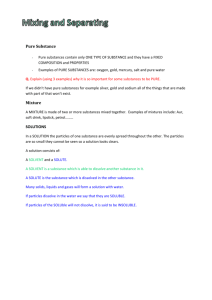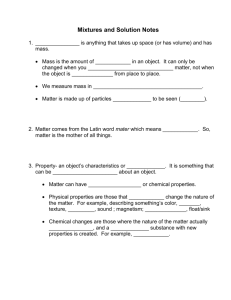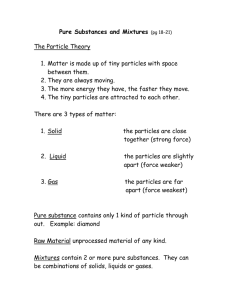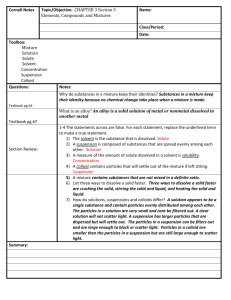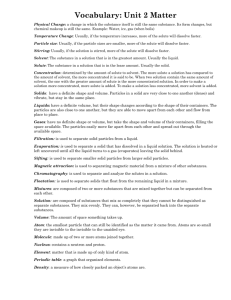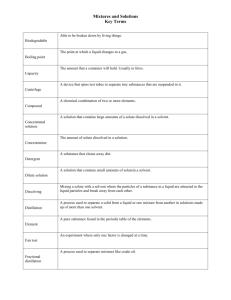Properties of Matter: Mixtures and Solutions
advertisement
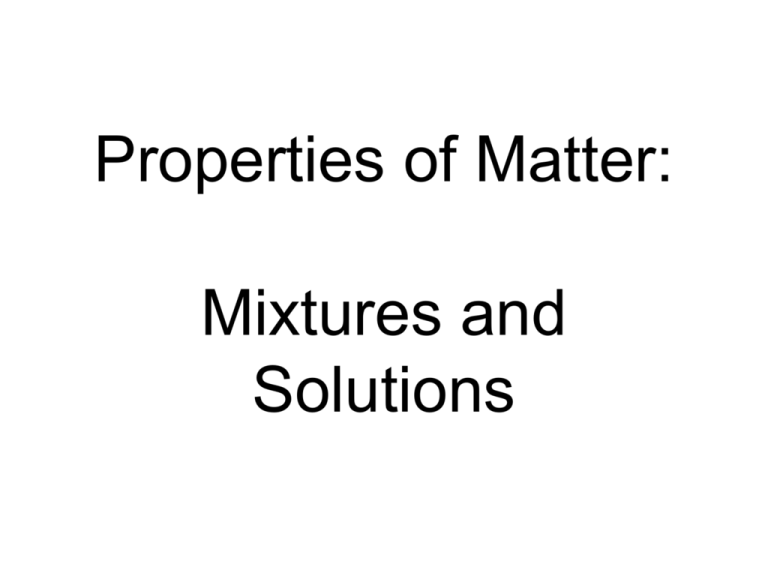
Properties of Matter: Mixtures and Solutions 1. MATTER is anything that takes up space (or has volume) and has mass. •Mass is the amount of MATTER in an object. It can only be changed when you ADD OR TAKE AWAY matter, not when the object is MOVED from place to place. •We measure mass in KILOGRAMS (kg) and GRAMS (g). •Matter is made up of particles TOO SMALL to be seen (ATOMS). 2. Matter comes from the Latin word mater which means MOTHER. So, matter is the mother of all things. 3. Property- an object’s characteristics or TRAITS. It is something that can be OBSERVED about an object. •Matter can have PHYSICAL or chemical properties. • Physical properties are those what DO NOT change the nature of the matter. For example, describing something’s color, ODOR, texture, TASTE, sound, magnetism, SOLUBILITY, float/sink. • Chemical changes are those where the nature of the matter actually CHANGES, and a NEW substance with new properties is created. For example, RUST. 4. Matter can be classified in different ways. •By its state. •Whether it is a substance or a MIXTURE. •The three states of matter are: Solids Liquids Definite shape Gases No definite shape- takes the shape of the container it’s in Definite volume Definite volume No definite shape or volume- they take the shape and volume of the container Particles are tightly packed together and only vibrate Particles are the most spread apart Particles are close, but less tightly packed together (they flow) Solids Liquids Particles stay in Particles can the same place slide past one another and change places Gases Particles move past each other very easily SOLID LIQUID GAS 5. How to find the volume for: •Solids- L* W*H (for rectangular items) or water displacement (for irregular items) H L W •Liquids- pour liquid in a graduated CYLINDER or syringe •Gases- in a graduated SYRINGE: 6. A substance is a kind of matter that is made up of only ONE KIND of matter. (ex: elements and compounds) 7. Mixtures are made up of 2 OR MORE different substances that DON’T change their identities when mixed. The different substances remain the SAME even when close together. •Each substance keeps its OWN IDENTITY and can be easily separated by PHYSICAL means. •Examples of physical means includes EVAPORATION, filtration, SIFTING, magnetic attraction, floatation, and chromatography. •Examples of mixtures include BIRDSEED, SALAD, TRAIL MIX. 8. Evaporation: used to separate a SOLID that was dissolved in a LIQUID. The liquid is heated until it turns into a gas, leaving the SOLID behind. •If you drop Kool Aid on the kitchen floor and don’t wipe it up, what happens? The water eventually disappears, but the sticky Kool Aid mixture remains on the floor. 9. Filtration- used to separate SOLID particles from a LIQUID by pouring the mixture through a FILTER PAPER in a funnel. The filter TRAPS the solid particles and lets the water pass through. Examples: COFFEE FILTERS, strainers/colanders in your kitchen 10. Sifting: used to separate SMALLER solid particles from LARGER solid particles. The mixture is put into a container with various sized SCREENS, is shaken, and then the smaller particles go through the screen and leave the larger particles in the container. 11. Magnetic attraction: used to separate MAGNETIC material from a mixture of other substances. Did you know that a “cow magnet” is given to a cow to swallow? It stays in the cow’s first stomach to keep magnetic material like wire and other hurtful materials from going into the rest of its digestive system! What are Cow Magnets? Cow magnets are popular with dairy farmers and veterinarians to help prevent Hardware Disease in cattle. While grazing, cows eat everything from grass and dirt to nails, staples and bits of bailing wire (referred to as tramp iron). Tramp iron tends to lodge in the honeycombed walls of the reticulum, threatening the surrounding vital organs and causing irritation and inflammation, known as Hardware Disease. The cow loses her appetite and decreases milk output (dairy cows), or her ability to gain weight (feeder stock). Cow magnets help prevent this disease by attracting stray metal from the folds and crevices of the rumen and reticulum. One magnet works for the life of the cow! 12. Floatation: used to separate solids, which FLOAT, from remaining liquids in a mixture. When the liquid is stirred, the solids can be SKIMMED off the surface. 13. Chromatography: used to separate and analyze SOLUTES in a solution. A small amount of SOLUTION is placed on a piece of filter paper, which is then placed in a solvent (usually WATER). •The solutes that dissolve EASILY will travel UP the filter paper. Those that do not dissolve easily will not travel very far. •With this method, chemicals in INKS AND DYES can be separated and analyzed. 14. There are several types of mixtures: •Solid-solid: SALAD TRAIL MIX •Solid-liquid: salt water, sugar water, KOOL AID, cereal and milk •liquid-liquid: milk and syrup, oil and water, water & FOOD COLORING •Gas-liquid: SODA 15. Under certain conditions, substances can CHEMICALLY combine when mixed, and then the NEW substance formed can’t be easily SEPARATED into its original parts. •For safety reasons, NEVER combine cleaning materials. A new substance can be formed which can be harmful to BREATHE and to touch. 16. A solution is a SPECIAL KIND of mixture in which the particles are evenly spread out. They BLEND together. •The particles are so small that they can’t be SEEN. •Solutions can be separated, but not as EASILY as most mixtures. •Can be made with SOLIDS, LIQUIDS, and GASES. 17. Solutions have two (2) main parts: (A) SOLVENT- the material in the GREATEST amount . It is what something gets dissolved IN and is usually a LIQUID. The universal (or MOST COMMON) solvent is water or H2O. (B) Solute- the material in the SMALLER amount . It is what GETS dissolved in the solvent and is usually a SOLID (but can be a liquid or a gas). SOLVENT Water SOLUTE Lemon juice (or powder if it’s kool aid) 18. Examples of solutions include KOOL AID, TEA, broth, coffee, WINDOW CLEANER, bleach, vinegar. 19. All solutions are MIXTURES, but not all mixtures are SOLUTIONS. Think about it this way: all beagles are dogs, but not all dogs are beagles. A beagle is one type of dog, just like a solution is one type of mixture. LOTTSA DOGS 20. Liquid solutions are usually TRANSPARENT or clear. However, they can be colored or colorless. 21. Solubility: the ability to be DISSOLVED. Some substances are easier to dissolve than others. 22. Factors that may affect the rate or speed the solute dissolves: •Particle size or surface area: SMALLER size will usually dissolve FASTER. Think about this: would a sugar cube or a sugar packet of loose sugar dissolve easier in water? The packet because the pieces are smaller than the compacted cube. We can CRUSH a substance to make it smaller. ? •Stirring or SHAKING the solute in the solvent. •Temperature changes: when HEAT is increased, more solute will dissolve faster. 23. Concentrated or concentration: when the solute is GREATER than the solvent, it can’t completely dissolve. The solute that does not dissolve will be LEFT AT THE BOTTOM. 24. Dilute or dilution: to LESSEN the strength of a solution by MIXING it with more liquid or more SOLVENT. Some cleaning supplies can be DILUTED with water to weaken their strength. If your tea or lemonade is too sweet, you can dilute it with water. 25. POLLUTION or harmful substances in our environment result from the MIXING OR DISSOLVING of foreign substances in water, air, and soil. They are often created as a result of industry, agriculture, burning FOSSIL FUELS, and other human activities.

